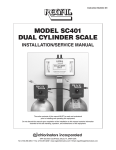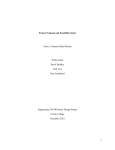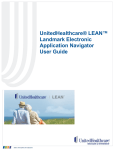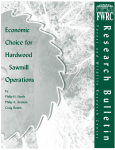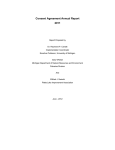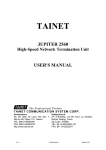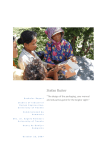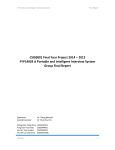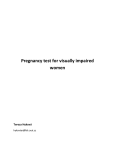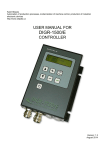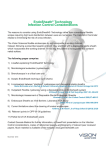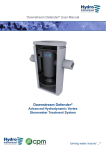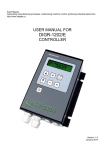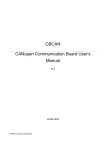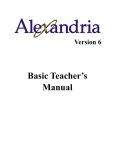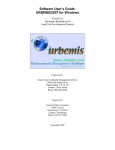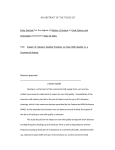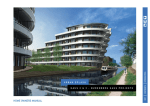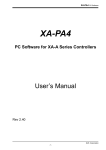Download Monitoring and Evaluation of a Point-‐of-‐Use Water
Transcript
July 13 Monitoring and Evaluation of a Point-‐of-‐Use Water Treatment Pilot Project in the Peruvian Amazon Lia Brune, Ahn Lee, Johnny Moreno, Camila Restrepo, Elizabeth Travis Research Advisor: Jami Nunez Faculty Advisor: Karl Linden Project Partners: Universidad Nacional de la Amazonía Peruana (UNAP) Bernuy Zumaeta Marcelo Cleydi Paredes Meneses Reynaldo Javier Minaya Vela Carlos Andrés Medina López Helita Del Carmen Cardenas Goncalvez Moniika Stheefanny Paredes Carmen Valeria Vela Hernández Gober Maytahuari Aricari U n i v e r s i t y o f C o l o r a d o B o u l d e r Table of Contents Introduction ................................................................................................................. 3 Project History ............................................................................................................................................................ 3 Water Treatment System ....................................................................................................................................... 4 Sampling Methodology ................................................................................................ 5 Household Surveys .................................................................................................................................................... 5 Water Quality ............................................................................................................................................................... 6 Survey Findings ............................................................................................................ 7 Use .................................................................................................................................................................................... 7 Treatment ..................................................................................................................................................................... 7 Maintenance ................................................................................................................................................................. 8 System Condition ....................................................................................................................................................... 9 Satisfaction ................................................................................................................................................................ 10 Water Quality ............................................................................................................ 10 Turbidity ..................................................................................................................................................................... 10 Fecal Contamination .............................................................................................................................................. 11 28 de Octubre, July 23, 2013 ............................................................................................................................... 11 7 de Julio, July 26, 2013 ......................................................................................................................................... 12 Nuevo San Juan del Amazones, August 2, 2013 .......................................................................................... 12 Cumulative Results ................................................................................................................................................. 13 Summary ..................................................................................................................................................................... 13 Recommendations ..................................................................................................... 14 User Manual .............................................................................................................................................................. 14 Chlorine addition in the 3rd bucket ................................................................................................................. 15 Increased Coagulation Time ............................................................................................................................... 15 Covering of the 3rd bucket ................................................................................................................................... 15 Explicit User Responsibilities ............................................................................................................................ 16 Contact Information .............................................................................................................................................. 16 Sources ...................................................................................................................... 17 Appendix – Survey questions ..................................................................................... 18 Introduction Project History The Civil Association for the Conservation of the Peruvian Amazon Environment (CONAPAC) is a non-‐governmental organization (NGO) that promotes education and clean drinking water in communities along the Amazon and Napo rivers in Peru. CONAPAC has partnered with students and faculty at the University of Colorado (CU) Boulder to conduct monitoring and evaluation of water treatment plants and point of use water treatment systems implemented in these areas. The collaboration has been facilitated by a National Science Foundation (NSF) – International Research for Students (IRES) grant (IRES: Toward Sustainable Water and Sanitation Infrastructure National Science Foundation OISE – 1065050; Karl Linden, PI). The project is in its third year of annual monitoring and evaluation. The 2013 IRES team consisted of students from the University of Colorado and the National University of the Peruvian Amazon (UNAP). The collaboration meets the goal of the IRES grant to bringing together students from interdisciplinary backgrounds to achieve a comprehensive level of research in sustainability. The group from CU is comprised of four graduate students and two undergraduate students in the diverse fields of environmental engineering, political science, geography and environmental science. Water treatment systems were evaluated not only from a technical standpoint but for political and sociological factors as well. The technological, sociological, and economic factors of a project are fundamental to resilience and sustainability, highlighting the importance of a multifaceted approach to the IRES research. CONAPAC is currently piloting a point-‐of-‐use (POU) water treatment system that incorporates a Sawyer membrane filter in three communities located on the Amazon and Napo rivers: 28 de Octubre, 7 de Julio, and Nuevo San Juan de las Amazonas. The small population and distance between the homes of these communities has made the installation of water treatment plants an inefficient solution. As a result, these communities were selected for a pilot project to test the effectiveness of POU treatment systems in the area. Through this pilot project CONAPAC aims to discern whether implementation of the POU system in similar communities as the primary form of drinking water treatment is feasible. Furthermore, the long-‐term goal is to expand the use of the POU system by making it an auxiliary option for communities whose access to water treatment plants is affected by annual flooding. Of the three communities selected, the households that agreed to participate in the study were given the POU system at no cost and were required to sign a contract stating that the study period was six months and after that time the households could purchase the system for 50 soles if they would like, otherwise the system would be collected by CONAPAC. The contract also stipulated participation in household visits by the CU research team. All of the households that were present during the CONAPAC solicitation visit to their community agreed to participate in the study, a total of 61 households. The POU systems were installed during April and May of 2013. Households were provided verbal instruction of proper water treatment during installation of the POU system and a laminated instruction sheet on proper configuration and backwash was distributed with the systems. The CU research team visited the communities approximately three months after installation of the POU systems. Water Treatment System The CONAPAC POU System is a three-‐step water treatment process consisting of three plastic 20-‐liter buckets and a Sawyer PointONE Filter, which uses hollow-‐fiber membranes (Figure 1). The Sawyer component of the POU system consists of the membrane filter and hose, a syringe for backwashing, a carving utensil for connecting the filter to a Figure 1. Sawyer PointONETM hollow-‐fiber membrane filter kit bucket, and a hanging device in order to hang the filter from a bucket. The filter is designed to achieve 0.1-‐micron filtration at all times, resulting in 99.99% removal of bacteria, protozoa, and cysts (Sawyer, 2013a). Figure 2 shows the 3-‐bucket POU system installed in a household. Raw water is collected from a river or stream using the first bucket. Raw river water turbidity has been found to range between 70 to 150 nephelometric turbidity units (NTUs), based on findings from previous visits by CU students. Users are instructed to swirl a solid aluminum chloride crystal, which is sold in the nearby city of Iquitos, for 60 seconds in the first bucket to allow for coagulation to occur. The aluminum chloride binds with the natural organic matter present in the raw water and settles to the bottom of the bucket. This step in the treatment process was added by CONAPAC to increase the efficiency and lifespan of the Sawyer filter by removing the suspended solids before they pass through the filter. The water from the first bucket is then manually poured into the second bucket. Care must be taken to keep the suspended solids that have settled in the first bucket from becoming reentrained and entering the second bucket. The last step of the filtration process is the passing of the water from the second bucket through the Sawyer filter and into the third bucket. The filter is connected to the side of the second bucket through a connector valve located near the bottom. Water is gravity fed through the filter and is passed into the top of the uncovered third bucket through a small hose. The third bucket serves to store treated water, and has a collection tap to prevent recontamination that can occur by dipping utensils into the bucket itself. Users are instructed to backwash the filter as needed by using a 60 mL syringe to pass treated water through the filter three times in the reverse direction of water flow during treatment. Sawyer advertises that when consistently backwashed the filter has an average flow rate of 46.6 liters per hour at sea level with a pressure head of 35.60 cm to 66.00 cm (Sawyer, 2013b). Sampling Methodology The IRES team evaluated the use, sustainability, and effectiveness of the Figure 2. CONAPAC point-‐of-‐use water POU system through household treatment system installed in a household surveys and water quality testing. The survey looked at the use and sustainability of the system while the water quality tests were used to identify fecal contamination at different points within the system. Household Surveys The research team attempted to survey every household in communities that received a POU system. Each of the three POU communities is relatively small, allowing for a complete and thus more representative assessment of the POU system. According to the data CONAPAC provided, there are a total of 61 households in the three communities with POU systems: 25 in 28 de Octubre, 15 in 7 de Julio, and 21 in Nuevo San Juan de las Amazonas. Out of 53 surveyed households, 49 had a POU system. Each survey lasted approximately 25 minutes. Initially the surveyor informed the interviewee, a member of the household; of the purpose of the survey and that his or her participation was completely voluntary and anonymous. If the interviewee gave consent and was 18 years or older the surveyor would proceed. Survey questions covered research Figure 3. Schematic of the Aquagenx Compartment Bag Test areas such as water use, consumption rates, water treatment, storage, satisfaction, community cohesion, and demographics. The survey also included observation questions for the interviewer about the appearance of the POU system. Water Quality The Aquagenx Compartment Bag Test (CBT) was used to assess the presence and concentration of E. coli, an indicator organism for fecal contamination. The CBT consists of a bag with five compartments of varying volumes, with a total volume of 100 mL (Figure 3). The presence or absence of E. coli in each compartment is used to determine the probability that E. coli is present in the water sample and provides the most probable number (MPN). The CBT method was selected for microbial sampling in the field because it does not require refrigeration, is compact and light, and provides a most probable number. As shown in Figure 4, samples were collected at three points within the POU system. The first sample site, labeled 2 in Figure 4, was collected from the second bucket after coagulation. Results from this point provided information about the E. coli concentration present in the water prior to its passage through the filter. The second sample site was taken directly after the water had passed through the Sawyer filter at sample site 2.5. Results from this sample site indicate whether or not the Sawyer filter is effectively removing bacteria. The third sample site was collected at the tap of the third bucket and was labeled sample site 3. Results from this point demonstrated whether or not recontamination had occurred in the third bucket during the storage period. Duplicate and sometimes triplicate samples were collected Figure 4. CONAPAC point-‐of-‐use system sample sites at the various sample sites to ensure quality control. Turbidity, the degree to which light traveling through a water column is scattered by the suspended solids, was measured in some of the households using a HACH 2100P field turbidimeter. The lower the turbidity the clearer the water appears. The HACH 2100P has a detection limit of 0.01 NTU. The turbidimeter was calibrated immediately before use to ensure accurate results. Turbidity was measured at sample site 2 in order to quantify the typical turbidity that passes through the filter and at sample site 2.5 in order to measure how much turbidity is being removed by the filter. When the flow rate coming out of the Sawyer® filter was too slow to collect a 100 mL sample for the CBT, 3MTM Petrifilm E. coli/Total Coliform count plates were used. Total coliforms are another indicator of fecal contamination. A syringe was used to collect 1 mL of water from a sterile sample bottle with water directly from the filter. The 1 mL sample was placed on the Petrifilm containing a growth medium for coliforms. Samples were incubated for 48 hours and results were quantified as coliform forming units (CFUs) (3M, 2013). Survey Findings Survey results are presented in the following sections based on the research areas of water use, treatment, maintenance, system condition, and satisfaction. A total of 53 households of the reported 61 households that are in the three communities studied, were surveyed. Of the four households visited that did not own a POU system, two households reported that they were simply not home when the systems were distributed. Note that Tables in this section report responses of 101 and 102 suggesting the user responded “do not know” or did not respond to the survey question, respectively. Use All of the households with a POU system reported that the systems were currently functioning and the vast majority of respondents described the system as either “very easy” or “easy” to use. Four percent described the system as “not easy” and two percent described the filter as “difficult” to use. Table 1 shows what households reported when asked how often they treat water in a normal week using the POU system. The large number of households that are treating water less than every other day suggests that users are storing water for multiple days, thus increasing the likelihood of contaminating treated drinking water. Due to the lack of a residual disinfectant in the treated water, there is no barrier against microbes that enter the third storage bucket due to improper handling, i.e. dipping a utensil or hand in the bucket or leaving the bucket uncovered. Table 1. Frequency of household water treatment per week Treatment per week 1 2 3 4 7 14 21 Response frequency 8 11 10 2 16 1 1 Treatment Only 1 household out of 43 reported that the system does not always work. The household’s explanation for the system’s malfunction was a lack of alum for coagulation rather than a problem with the POU system filter. Table 2 displays the variation in the amount of time users spent mixing the coagulant in the first bucket. During the distribution and installation of the POU systems, CONAPAC recommended that users swirl alum for 60 seconds in the first bucket. However, lab tests conducted at CU Boulder have shown that a minimum of 120 seconds of swirling is necessary in order to settle out the maximum amount of turbidity. A majority of households reported swirling water for only 30 seconds, suggesting that they either never received a recommendation for how long to swirl the alum or are swirling for less time in order to conserve the alum. There is a lack of understanding of the appropriate amount of time to swirl alum, most likely leading to less than optimal coagulation and settling. Thus resulting in higher turbidity passing through the filter, which can lead to lower flow rates passing through the filter and possible clogging. Table 2. Amount of time users swirl the coagulant in the first bucket Swirling time (in seconds) 2 30 32 60 101 Response frequency 1 29 1 17 1 Reported settling times were also found to vary between households. As Table 3 shows, the majority of households reported allowing 30 minutes for settling in the first bucket before pouring water into the second bucket. Lab test results conducted at CU Boulder found that a settling time of 40 minutes is ideal. The lack of consistency among respondents indicates that an optimal settling time has not been effectively communicated to users. Table 3. Settling time in the first bucket Settling time (minutes) 5 15 20 30 45 50 60 101 102 Percent of total responses 4 2 2 69 2 2 13 4 2 Maintenance Out of the 49 households surveyed, 48 acknowledged that they occasionally needed to clean the filter and most reported the need to clean it after every use. Table 4 shows the little variation in the frequency with which households reported backwashing their filter. Overall, users seemed to understand the need to backwash the filters and the majority backwash every time they treat water. This is largely attributed to the total inability to treat water, i.e. no water passing through the filter, without backwashing after every bucket of water treated. It should be noted that the flow rates advertised by Sawyer are based on testing that used recreational waters that have naturally low turbidities, which is in stark contrast with the water sources being used in these communities. Based on the few number of households where turbidity was measured, the average turbidity of water before passing through the Sawyer filter was found to be 10 NTUs. Large variation in the turbidity of the water passing through the filter is expected due to the large variation in water treatment methods used in households. Table 4. Frequency of filter backwash Number of buckets treated before backwash 1 2 3 4 101 Frequency of response 29 12 3 3 2 Table 5 shows variation in the number of times households backwashed the filter using the syringe provided with the POU system. The variation in these responses suggests two possibilities, though not mutually exclusive; 1) knowledge regarding maintenance requirements varies widely between households; 2) maintenance guidelines that suggest flushing three 60 mL syringes of treatment water through the filter are insufficient. It should be noted that users do not have a user manual to reference for information on proper backwashing. Lab tests conducted at CU Boulder found that flow rates through the filter during water treatment improved when backwashed with a syringe six to nine times. Table 5. Number of syringes used to backwash filter Number of syringes 1 2 3 4 5 6 8 10 15 101 Frequency of response 6 3 12 6 5 4 1 3 3 5 System Condition In regards to the condition of the systems, surveyors found that approximately 35 percent were in “perfect” or “near perfect” condition, 58 percent were in “good” condition, and 5 percent were in “poor” condition. One POU system was reported to not be in use. Only one of the 39 systems was reported to have a leak (Figure 5), and the user of the system had attempted to plug the leak using a plastic bag. A total of 18 percent of the 49 systems were missing a lid on the third bucket at the time of the visit, while the collection tap in the third bucket was not functioning in 10 percent of the POU systems. A total of 11 out of 49 households reported that they did not have alum. Six of these households were in Nuevo San Juan de las Amazonas, where CONAPAC arranged for surveyors to distribute alum during their visit. It is important to note that some households in Nuevo San Juan de las Amazonas responded that they did have alum because they had received it on the day of the survey. Thus, the data may not reflect the situation as it was prior to the survey. Aside from not having alum, the systems were generally in good condition. It should be noted though that the visit occurred only three months after the systems had been installed, thus a follow Figure 5 A leak in the Sawyer filter up survey conducted at a later date would provide tubing. a more accurate representation of how the system will perform in the harsh Amazon environment over time. Satisfaction Most households, 55 percent, reported high filter flow rates, while 35 percent reported slow flow rates, and 6 percent reported that flow rates were too slow. When asked if after six months they would be willing to purchase the system 96 percent of households responded “yes.” Table 6 shows the amount of money respondents stated they would be willing to pay per month for the POU system, if this was an option that CONAPAC offered. While most households demonstrated a willingness to purchase the system with one payment of 50 soles, these findings suggest a preference to pay in monthly increments. The most common incremental value was 10 soles per month. Table 6. Desired monthly payment for POU system Willingness to pay per month 1 3 5 15 20 25 50 100 101 Frequency of response 1 1 7 10 1 4 3 8 1 Water Quality Turbidity The CONAPAC POU system removes turbidity primarily through the use of alum in a coagulation process and secondly through the Sawyer membrane filter. The removal of turbidity was between 86 and 98.8 percent in the six filters whose turbidity was measured in the field both before and after treatment. According to the World Health Organization (WHO) the maximum allowable turbidity in drinking water is below 5 NTU, with a preferable measure of below 1 NTU to ensure that chlorination will be effective if in use (Adams, 2009). Turbidity measurements following treatment with the Sawyer filter were collected in 12 different households. Final turbidity readings after the filter ranged between 0.27 and 1.66 NTUs, with only two samples reading above 1 NTU. The average NTU for the third or final bucket was 0.65 NTU. While turbidity was only tested after filtration in 12 households, the results indicate that between coagulation with alum and the Sawyer filter, turbidity is being removed to a level that meets WHO standards. An important corollary of this finding is that a 1.1 log reduction in E. coli concentration due to coagulation using the alum crystal in the first bucket has been shown in investigations into the effectiveness of the POU system conducted at CU Boulder. This emphasizes the importance of removing turbidity for improving water quality and reducing the presence of pathogens. It should be noted though that the coagulation process with alum needs to be improved in order to put less stress on the Sawyer filter, and thus improve flow rates through the filter and overall lifespan. Fecal Contamination The water quality results of POU system pilot study are discussed below for each of the three communities separately before analyzing the results as a whole. While the goal of water quality testing of the POU system was to take water samples from sites 2, 2.5 and 3 from every household in each of the three communities, this was not possible in many cases. Barriers to taking samples at each site and in each household included leaking of the CBTs, availability of water to sample in both the second and third buckets, and the low flow rates from the filter at sample site 2.5. 28 de Octubre, July 23, 2013 Of the 23 households in the community of 28 de Octubre, 21 were surveyed (Table 7). Due to the complications previously explained, water samples were collected at a total of 15 households, 65 percent of the households in the community. At sample site 2, in the second bucket, 73 percent of the households showed zero fecal contamination. As this sample site is prior to filtration through the Sawyer system but after coagulation, it was expected for some microbial contamination to remain. Possible explanations for these unexpected results are low initial contamination and removal via coagulation, inadequate incubation time due to lower than expected ambient temperatures, or inadvertent disinfection of samples due to prolonged exposure to the sun. It should be noted that the CBT tests only for E. coli and not other possible pathogens. Table 4. Fecal contamination results from 28 de Octubre Sample site 2 Sample site 2.5 Sample site 3 Number of 15 12 15 samples % Positive for 26.7% 16.7% 13.3% contamination % Negative for 73.3% 83.3% 86.7% contamination Of the 12 samples collected directly from the filter at sample site 2.5, 17 percent, 2 samples, were found to be contaminated. Both of these contaminated samples tested negative for E. coli before passing through the filter. Possible explanations for this are that contamination occurred during the sampling process or that there is microbial growth within the filter itself. Of the 15 samples collected at samples site 3, two samples tested positive for fecal contamination. Both of these positive samples were collected from Sawyer systems that tested negative for contamination at sample site 2.5, indicating recontamination in the third bucket. The two filters that tested positive for contamination at sample site 2.5 tested negative at sample site 3. Again, this could be due to mishandling during sample collection and analysis. Based on these results, fecal contamination exists in the water being consumed and additional treatment should be added the POU system. A residual disinfectant, such as chlorine in the third bucket, would decrease the possibility for regrowth due to the chlorine residual allowing for continual disinfection during storage. 7 de Julio, July 26, 2013 Of the total 16 households in 7 de Julio, 81 percent were surveyed. Of these, water quality was tested in 75 percent of the households. At sample site 2, only seven households had water available to sample. Of these, 43 percent tested negative for contamination and 57 percent tested positive. Again, the lack of contamination in the second bucket in many households may be due to low amounts of initial contamination, variation in the coagulation and settling time, or sampling error. Six POU systems were tested at sample site 2.5. Of these, three were tested using the CBT, while three were tested using Petrifilm. Three of these filters tested negative for contamination, while the other three tested positive, though at low levels. Where samples were taken at sample sites 2 and 2.5 for the same filter, the results were consistent with what was expected, if sample site 2 showed no contamination neither did sample site 2.5. Samples were collected at sample site 3 in ten households. Four of these samples tested negative for fecal contamination. The other six samples tested positive. One sample had a MPN of greater than 100 E. coli per 100 ml, one sample had a MPN of 48.3 per 100 ml, and the other four samples had MPNs below 4.7. Table 5. Fecal Contamination Results, 7 de Julio Number of samples % Positive for contamination % Negative for contamination Sample site 2 7 57.2% Sample site 2.5 6 50% Sample site 3 10 60% 42.8% 50% 40% Nuevo San Juan de las Amazonas, August 2, 2013 There are 21 households in the community of NSJ del Amazonas. Of these households, 81 percent were surveyed and 76 percent had their POU system tested for water quality. Most of the drinking water in this community is collected from large ponds. None of the households had alum before our visit. Samples were collected from sample site 2 in five households and all of these samples tested positive for fecal contamination. Five samples were collected from sample site 2.5 and only one sample tested negative for contamination. Of the other four samples, two tested for low contamination with 1.5 and 2.5 MPN and the other two samples had MPNs of 48.3. A total of 16 households had their water tested at sample site 3. Three tested negative for fecal contamination. Of the remaining samples, one had a MPN of 1.1, two had MPNs of 13.6, three had MPNs of 48.3, and seven had MPNs of greater than 100. The contamination of water in the third bucket can be attributed to improper storage of water, thus furthering the case for a chlorine residual in the third bucket to form a secondary barrier against microbial contamination. It is unclear what caused such high levels of contamination in the treated water of NSJ del las Amazonas. Qualitative observations of household practices suggest an understanding of appropriate treatment procedures. It is possible that the frequent contamination is due to higher levels of fecal contamination in the source water, malfunctioning of the POU filters due to a lack of alum and higher turbidity levels, or microbial growth inside the filter. Table 6. Fecal Contamination Results, Nuevo San Juan de las Amazonas Number of samples % Positive for contamination % Negative for contamination Sample site 2 5 100% Sample site 2.5 5 80% Sample site 3 16 81.2% 0% 20% 18.8% Cumulative Results When looked at cumulatively (Table 9), the water quality results indicate that the quality of drinking water is improved with the use of the POU system, but is not consistently providing water that is safe for consumption. It is important to note that fewer samples were collected at sample sites 2 and 2.5 than at site 3. However, overall contamination levels at around 50 percent in the third bucket, whether due to failure of the system, sampler error, or recontamination, are an indication that further action is needed to ensure that households are drinking clean water. Table 7. Fecal Contamination, all three communities Number of samples % Positive for contamination % Negative for contamination Sample site 2 27 48.1% Sample site 2.5 23 39.1% Sample site 3 41 51.2% 51.9% 60.% 48.8% Summary Based on the water quality results, the POU surveys, and the impressions of the surveyors, these systems have the potential to provide clean drinking water to users. The POU system is an attractive option for residents of small communities whose population or geographic layout makes the installation of centralized water treatment plants unfeasible. The use of alum for coagulation, when used correctly, has the potential to decrease turbidity levels to ranges around 10 NTUs. This is a major benefit as turbidity serves as a major conduit for pathogenic microorganisms. In addition to this benefit, the appearance of the final water offers an important pathway to making clean water consumption a symbol of social status. Households that have the POU system showed an overwhelming willingness to pay for the system following the trial period. The households consistently asserted that they used the system. Interviewers noted that all but one system appeared to be in use while 93 percent of systems were in good or perfect condition. This indicates a commitment to improving drinking water quality and a willingness to take ownership for providing it. Furthermore, we were able to observe the water treatment process in a number of households. Qualitative observations of household practices suggested an understanding of appropriate treatment procedures. If the system is adjusted so that recontamination is minimized through the use of chlorine and the optimum procedures for treatment are properly communicated, then residents appear capable of using the system effectively. There are, however, a few caveats. As mentioned above, further action has to be taken to address fecal contamination in the final bucket. Adjusting the system so that the third bucket remains closed and adding chlorine should prevent recontamination and serve as a secondary barrier against microbial contamination. In addition, there needs to be better communication regarding the roles and responsibilities of community members and CONAPAC regarding system maintenance and also concerning optimal use of the system. Recommendations Our conclusions regarding the future feasibility of using the POU system hinge on improvements in communication between CONAPAC and recipient communities’ as well additional refinements to the system aimed at improving water quality. Below are recommendations developed with both the shortcoming of the current setup and it’s potential for transformative use in the future in mind. User Manual The existing manual that was included with the POU systems does not explain the full water treatment process. Thus, it is recommended that users be provided with a printed and laminated Spanish water treatment instruction manual for households to properly operate the POU system. Such a manual will reduce the common misconceptions and improper water treatment that was evidenced during household visits. Important instructions to include in the manual are as follows: 1) Swirl coagulant in first bucket for 120 seconds, or 120 swirls. 2) Allow water to settle for a minimum of 40 minutes. 3) After settling, transfer water into the second bucket, trying to prevent the settled particulate matter from becoming reentrained in the water during this transfer. Water will then flow through the Sawyer filter. The water should flow freely, without interruption. 4) The filter needs to be backwashed before each new bucket of water is treated, or more frequently if flow rate slows down significantly. During backwashing, treated water is passed through the filter using a 60 mL syringe in the reverse direction of water flow during treatment. Force should be applied to the syringe in order to flush out particulate matter inside the filter. A minimum of five syringes of treated water should be passed through the filter during backwash. 5) Add one to two drops of liquid chlorine to third bucket to attain free chlorine in the water. After chlorine addition, shake the bucket manually, with the lid closed in order to prevent spillage, in order to mix the chlorine. After mixing, let the bucket sit for approximately 30 minutes to allow time for the chlorine to disinfect the water. 6) Water from third bucket is now treated and ready to consume. Be especially careful not to insert hands or utensils into this bucket, as this increases the risk of recontamination. Instead, always use the tap to collect water. 7) Keep the third bucket covered at all times. 8) Should the filter malfunction, contact CONAPAC. Provide contact information. When alum is needed, it can be purchased in Iquitos. CONAPAC will not provide alum. Chlorine addition in the 3rd bucket One recommendation is that the system be augmented with the addition of chlorine in the third bucket. Storage time is an unknown variable and increasing storage time can lead to an increased chance for recontamination. Adding chlorine would help prevent recontamination and also serve as a secondary method of disinfection. Increased Coagulation Time Increase the amount of time the user stirs the alum in the bucket. Lab results show a minimum of 120 seconds of swirling is necessary for proper coagulation. CONAPAC instructed 60 passes of the coagulant during the installation of the POU system and it was found that many households are only swirling the coagulant for 30 seconds. Covering of the 3rd bucket In order to safely contain and store the treated water in the third bucket, the lid to the third bucket needs to remain on the bucket at all times, including during filtration. The current setup requires that the lid for the third bucket be either off entirely or open at one end to accommodate the filter when it’s in use. Future POU systems should include longer tubing in order to allow the water to enter the third bucket from the side of the bucket through a small hole. Explicit User Responsibilities An important observation was disconnect between what users view as their responsibilities and what CONAPAC views as their role. Establishing guidelines and communicating user responsibilities would improve the resilience of the system. For example, if obtaining alum is the responsibility of households, it is important to communicate that upfront and perhaps provide household or communities with ideas regarding the best way that these resources can be obtained. If possible, helping communities organize community purchasing of alum may help reduce costs and ensure availability. This information should be provided in the user manual given to households. Contact Information CONAPAC’s contact information should be printed on the instruction manual to inform households on how and when to contact the organization should the filter malfunction. CONAPAC will likely be the only source of technical assistance in the event that filters malfunction, so routine communication with communities and a clear protocol for approaching CONAPAC when this occurs will be necessary to ensure the long term use of these systems and community trust in CONAPAC. It should be noted that the visit to the communities was conducted three months after the distribution of the POU system therefore it remains unknown how the filter will perform over time and how much support will be needed from CONAPAC to ensure the long term sustainability of these systems over time. Sources John Adams, J. B. (2009). Water, Sanitation and Hygiene Standards for Schools in Low-‐cost Settings. Geneva: World Health Organization. “Sawyer Filter Technology”. Sawyer Saves, 2013. Website, 18 September 2013. http://www.sawyer.com/sawyersaves/filter-‐tech.html "What can I expect as my flow rate from my PointONE FilterTM". Sawyer Saves, 2013. PDF, 18 September 2013. http://www.sawyer.com/sawyersaves/documents/flow-‐full.pdf "'Sawyer Saves' Offers Hope to 900 Million People with no Access to Clean Water". PRWeb, 19 March 2012. Online Article, 18 September 2013. http://www.prweb.com/releases/2012/3/prweb9288501.htm "3MTM PetrifilmTM E.Coli/Coliform Count Plates". 3M, 2013. Website, 18 September 2013. http://solutions.3m.com/wps/portal/3M/en_US/Microbiology/FoodSafety/ product-‐information/product-‐ catalog/?PC_7_RJH9U523003DC023S7P92O3O87000000_nid=C0WJ62882V be29BDXSBJ7Fgl Appendix – Survey questions Survey Number:________________ SURVEY FOR FAMILIES WITH POU SYSTEM SECTION 1: GENERAL INFORMATION Do not read Code GI001 Question Date of Interview Write (day/month/year) GI002 Time interview started (24 hours) GI003 Interviewer GI004 District GI005 Community GI006 Distance (in minutes) from household to school (estimated by interviewer) GI006d GPS Waypoint START SURVEY: read paragraph Hello, my name is __________ and I am working with the University of Colorado in the United States and the National University of the Peruvian Amazon. We are doing a study on water in your community. The interview will last approximately 30 minutes. Your participation is voluntary. You may choose not to answer any of the questions or elect to stop the survey at any time, and your answers will be completely confidential and anonymous. We are not affiliated with an NGO or the government. We are students. Are you over 18 years old, and willing to participate in this survey? GI009 Consent granted and over 18 years old (1) Yes (2) Under 18 (3) No Consent If “no,” thank the interviewee and go to the next house. If “yes,” thank the interviewee, and mark “consent granted” on survey. [Local contact in Iquitos: Profesora Giorly Machuca from UNAP ([email protected], telephone number: 965605211). Principal Investigator: Karl Linden, at [email protected] or (01) 303-492-4798] SECTION 2: QUESTIONS FOR ALL INTERVIEWEES: WATER USAGE OB014 Are you the head of household? (1) Yes (2) No (101) DK; (102) NR In a normal week, how many times do you collect drinking water from… WU002b The River ______ times per week (102) DK; (102) NR WU003b A well WU004b Rainwater WU010 (Skip this question if “0” for WU002b-WU005b and skip to SECTION 3) When you obtain water from ______(read most frequent source), do you treat it prior to consumption? WU015a How do you treat it? ______ times per week (101) DK; (102) NR ______ times per week (100)Every time it rains (100) DK; (102) NR (1) Yes (2) No (3) Sometimes (101) DK (102) NR (1) Alum (2) DIGESA system (3) Chlorine (4) Point of use Filter (5) Other: (101) DK (102) NR SECTION 3: QUESTIONS FOR ALL INTERVIEWEES: POINT OF USE FILTERS POU01 Do you have a POU for filtering water? 1 Yes 2 No Yes: Skip to POU05 (101) DK (102) NR POU02 We have heard that an organization named 1 Yes CONAPAC has distributed point of use filters 2 No for filtering drinking water in this community. (101) DK (102) NR Has this family received a POU filter? Yes: Skip to POU04 POU03 Other families have received a POU filter. Write reason: Why do you believe you did not? POU04 Skip to SECTION 4 What happened to the POU filter? (101) DK (102) NR Write: POU05 Skip to SECTION 4 May we see it? (101) DK (102) NR 1 Yes 2 No (101) DK (102) NR In answer is no, skip to POU07 POU06 POU07 POU08 POU09 May we take some water samples from the system? If permission to sample is granted, take sample from downstream side of the POU filter, then continue with the survey. If permission is not granted, continue with the survey. What is the filter number on the POU? (If number is unknown, check buckets for number) During which month did you receive the POU filter? Is the POU filter working? 1 Yes 2 No (101) DK (102) NR Write number: (101) DK (102) NR Circle: (1) February (2) March (3) April (4) May (5) June (6) July (101) DK (102) NR 1Yes If answer is yes, skip to POU12 POU10 Why is it not working? POU11 Have you attempted to repair the POU filter? POU12 Skip to POU13 Have you had to fix the POU filter? POU13 If yes, skip to POU15 What would you do if the POU filter stopped functioning? OB015 OBSERVATION For interviewer to annotate (do not ask): ¿How would you describe the condition of the system? OB015a OB015b For interviewer to annotate (not a question): Are there problems with the system such as: OB015c POU15 Do you have alum? POU16 Do you have a syringe? 2 No 3 Other (write): (101) DK (102) NR Write: (101) DK (102) NR 1 Yes 2 No (101) DK (102) NR 1 Yes 2 No (101) DK (102) NR Write: (101) DK (102) NR 1 Almost perfect or perfect 2 Good 3 Bad 4 Not being used (101) DK (102) NR Leaks: (1) Yes (2) No Lid missing on third bucket: (1) Yes (2) No Tap on third bucket not functioning: (1)Yes (2) No 1 Yes 2 No (101) DK (102) NR 1 Yes 2 No (101) DK (102) NR Now we have some questions about the POU system when it is working. POU17 How many times a week do you (or did you) filter water _____ times per ___________ with the POU system?? (101) DK (102) NR POU18 Do you think that it is (or was) _____ to use the POU 1 Very easy filter? 2 Easy 3 Not easy (read the responses) 4 Difficult (101) DK (102) NR POU19 (If POU filter is not functioning, skip this question) 1 Yes Does the POU filter always work? 2 Sometimes If yes, skip to a POU21 3 No (101) DK (102) NR POU20 Could you explain when it does not work and why? ____ [day/week] POU21 POU22 POU23 POU24 POU25 POU26 How many times do you swirl the alum crystal in the first bucket? How many minutes do you allow the water to settle in the first bucket? Do you have to clean the POU filter sometimes? If answer is NO: Skip to POU26 How many buckets of water do you filter before you have to clean the filter? How many syringes of water do you run through the filter when cleaning it? How fast does the water flow out of the filter? Read responses POU27 If after six months, CONAPAC offered to sell you the POU filter for 50 soles, would to purchase it? POU28 If CONAPAC gave you the opportunity to buy the system in payments, would you change your answer to the previous question? POU29 How much would you be willing to pay per month? (write answer) ___________ swirls (101) DK (102) NR ________________ minutes (101) DK (102) NR 1 Yes 2 No 3 Other (write): (101) DK (102) NR 1 One bucket 2 Two buckets 3 Three buckets 4 Other (write): (101) DK (102) NR ____________ syringes (101) DK (102) NR 1 Fast 2 Slow 3 Very slow 4 Other: _________ (write) (101) DK (102) NR 1 Yes 2 No 3 Maybe (101) DK (102) NR 1 Yes 2 No 3 Maybe (101) DK (102) NR _______per month SECTION 4: QUESTIONS FOR ALL INTERVIEWEES: COMMUNITY COHESION CC002 How often are community meetings held? ______times per month (101) DK (102) NR CC003 When community meetings are held, you or someone from (1) Always your households attends: (2) Almost always (Read responses) (3) Half the time (4) Almost never (5) Never (101) DK (102) NR CC01 Of all of the families in the community, how many would ______persons you say you’re able to talk with about about private 101) Does not Know matters? 102) No response CC03 How many people in this community give their time or 1 Everyone money to facilitate community development, for example 2 More than half to repair a path or work on a community project? 3 One half (Read responses) 4 Less than one half 5 Nobody 101) Does not Know 102) No response CC04 ____ times In a typical month, approximately how many times do you help your community or neighbors, for example in (101) DK (102) NR a community project or in any other manner? IE015 Have you ever asked a question at a community meeting? IE016b How often are the POU filters discussed at community meetings? (Read responses) (1) Yes (2) No (101) DK (102) NR (1) Never (2) Almost never (3) Half the time (4) Almost always (5) Every meeting (101) DK (102) NR SECTION 5: QUESTIONS FOR ALL INTERVIEWEES: KNOWLEDGE AND PROBLEMS C001 Were there problems pertaining to the POU filters in the (1) Yes community, or problems pertaining to water in general? (2) No If no response, skip to section XX (101) DK (102) NR C002 Why did these problems occur? Write: C003 How were these problems resolved? Write: Now we have some questions about the plant project. SECTION 6: QUESTIONS FOR ALL INTERVIEWEES: ABOUT THE PROVIDER II008 SM005d In the last year, how many times has your community had contact with CONAPAC? Do you believe the POU filter belongs to your family, the community, or CONAPAC? Do NOT read responses SAT02 How satisfied are you with the POU system? SAT03 Before receiving the POU filter, did you used to treat your drinking water? SAT04 SAT05 If no, skip to SAT05 What did you treat it with? Do you prefer to drink water the way you used to before receiving the POU filter, or do you prefer using the POU filter? SECCIÓN 7: JAMI’S _____times (101) DK (102) NR (1) Your family (2) CONAPAC (3) Community (4) Both (5) Other: (101) DK (102) NR (1) Very satisfied (2) Satisfied (3) Dissatisfied (101) DK (102) NR (1) Yes (2) No (3) Sometimes (101) DK (102) NR (1) Alum (2) Chlorine (3) POU filter (4) Other: (101) DK (102) NR (1) Drink water the way we used to (2) Use the POU filter (3) (101) DK (102) NR JN001 JN002 Would you say the current quality of life in this community is better, the same, or worse than it was three years ago? Do you believe the quality of life in this community will be better, the same, or worse three years from now? JN003_2 Would you say the services provided to this community by the municipality are: (Read choices) JN004 How interested do you believe the local government is in your community’s problems? (Read responses) JN005_4 Can you name your district mayor? 1) Better 2) Same 3) Worse 101) Does not Know 102) No Response 1) Better 2) Same 3) Worse 101) Does not Know 102) No Response 1) Very good 2) Good 3) Not good or bad 4) Bad 5) Very bad 101) Does not Know 102) No Response 1) Very interested 2) Somewhat interested 3) Not very interested 4) Not interested 101) Does not Know 102) No Response Write: 102) No Response JN006_5 How long is a mayor’s term? JN007_6 What is the name of the process used to remove a mayor from office? JN008_7 How long is a presidential term in Peru? JN009 On a different note, sometimes people and communities have problems they can’t resolve themselves. Have you ever requested help or aid from the local authorities such as the mayor or municipality in order to resolve problems? Have you attended a government meeting or spoken with a civil servant in the last 5 years? JN010_11b JN011 Of the following two statements, which one would you say applies most to you: It is the government’s responsibility to provide your family with services. Or It doesn’t matter who provides your family with services, as long as they’re provided. (4 years) 1) Correct 102) No Response 2) Incorrect (revocatoria) 1) Correct 102) No Response 2) Incorrect (5 years) 1) Correct 102) No Response 2) Incorrect 1) Yes 101) Does now Know 2) No 102) No Response 1) Yes Know 2) No 101) Does not 102) No Response 1) It is the government’s responsibility to provide my family with services 2) It doesn’t matter who provides my family with services, as long as they’re provided. 101) Does not Know 102) No Response Now I have some questions about organizations that are not from the government, who work with social matters such as education or nutrition. Examples of these organizations are Punchiwarmi, UNICEF, Operación Bendicion, o Cruz Roja. JN012_12 Are there organizations or groups that have worked with 1)Yes 2) No your community or someone in your community in the last 101) Does not Know 102) No 5 years? response JN013 If no, skip to JN020 Can you name these organizations or groups? Ask if there are more and write their names 1. Name: 2. Name: 3. Name: If they say that they don’t remember the names, mark this and continue 4. Name: 5. Name: If there are none, skip JN020 For coding JN013: could name/couldn’t name/no NGOs/NS/NR. Then JN013a-JN013e for names. JN014 What project or service did ______ provide? [state name of first organization or group] JN015 Would you say the results of this service or project were: (Read choices) JN016 If more than one organization could not be named, or did not recall, skip to JN018. JN017 JN018 JN019 JN020 What project or service did ______ provide? [state name of first organization or group] Would you say the results of this service or project were: (Read choices) Keeping in mind the organizations that have visited this community, have you or someone in your family received goods or services from these organizations or groups? In the last two years, how many times have you or someone in your family attended a meeting or spoken with these organizations? In general, how interested do you believe nongovernmental organizations are in problems in 90. Does not remember names, but there have been some 0. No organizations 101) Does not Know 102) No Response Write: 1) Very good 2) Good 3) Not good or bad 4) Very bad 5) Very bad 6) The organization did not complete the project 101) Does not Know 102) No Response Write: 1) Very good 2) Good 3) Not good or bad 4) Bad 5) Very bad 6) The organization did not complete the project 101) Does not Know 102) No Response 1) Yes 101) Does not Know 2) No 102) No Response ______times 101) Does not Know 102) No Response 1) Very interested 2) Somewhat interested JN021 communities like this one? 3) Not very interested 4) Not interested 101) Does not Know 102) No Response Who do you trust more to complete projects that will better your community? 1) NGOs, like organizations or groups 2) The government 3) Both the same 4) Neither 101) Does not Know 102) No Response (Read choices) SECTION 8: PERSONAL INFORMATION Now to wrap things up, I have some statistical questions. DG001 CC010 CC009 What is your age? How many months or years have you lived in this community? How likely is in that you will live in this community in three years? (read choices) Does your home have… DG002b A generator DG002c Solar power DG002 A radio DG003 A television DG004 Boat with a motor DG005 (Skip if they do not have electricity, but mark answer) A refrigerator A cellular pone (or house phone) DG006 DG007b_a How many of these animals do you own? (Read choices) ____ DK/NR = 0 ______years_____months DK /NR = 0 (1) Very likely (2) Somewhat likely (3) Not very likely (4) Not possible (101) DK (102) NR (1) Yes (2) No (101) DK (102) NR (1) Yes (2) No (101) DK (102) NR (2) Yes (2) No (101) DK (102) NR (1) Yes (2) No (101) DK (102) NR (1) Yes (2) No (101) DK (102) NR (1) Yes (2) No (101) DK (102) NR (1) Yes (2) No (101) DK (102) NR Cows: _______ DG007b_b Pigs: _______ DG007b_c Goats: _______ DG007b_d Chickens: _______ DG007b_e DG010 How many people live in this house? DG011 How many people under the age of 5 live in this Other:________ _________ (101) DK (102) NR _________ house? (101) DK (102) NR DG012: What is the highest level of education you completed? None Elementary Secondary College DK =101/NR=102 1st 0 1 7 12 2nd 3rd 4th 5th 6th 2 8 13 3 9 14 4 10 15 5 11 16 6 17 18+ DG012b: Of everyone living in your house, what is the highest level of education completed by the person with the highest level of education? 1st 2nd 3rd 4th 5th 6th None 0 Elementary 1 2 3 4 5 6 Secondary 7 8 9 10 11 College 12 13 14 15 16 17 18+ DK =101/NR=102 We’ve reached the end of our survey. Thank you for taking the time to speak with us. Your participation in this survey is greatly appreciated. We wish you and your family the very best. Do you have any questions for us? SECTION 9: INTERVIEWER OBSERVATIONS OB016 Does it look like they are using the system? OB007 How long did the interview take? OB008 Gender of person being interviewed OB013 Was there anything special or different about the interview we need to know? (Problems, impressions, anything special, etc.) 1 2 3 Yes Not sure, but it looks like they are Not sure, but it looks like they aren’t 4 No _______minutes (1) M (2) F


























